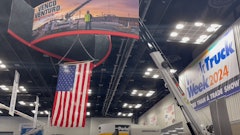
Contractors are keeping an eye on their bottom line to meet tighter schedules and bid requirements. At this year’s CONEXPO-CON/AGG, the largest construction trade show in the U.S., precision construction was at the top of everyone’s list to learn more about. Contractors want to understand opportunities to improve equipment efficiency through software and hardware additions to increase their fleet’s productivity.
Despite some potential flashes of recession, including higher than typical interest rates (about 6-7%), bank failures, and increases in building materials prices, money continues to flow into the U.S. nonresidential construction sector, according to a recent Associated General Contractors of America report.
More than a year ago, I shared some advice about how to make decisions during “stormy economic weather,” and many of those tips still apply to this year’s conditions. However, instead of forecasting the winds of change, I gathered some recommendations from contractors, technology experts and RDO Equipment Co. team members to weather challenges — whether due to inflation’s jetstream or predictable seasonal changes. Consider taking these steps to weatherproof your business.
1. Take the time to pick the piece of equipment that will work best for the operator.
It’s no secret that operators have unique experiences and learning preferences. It’s essential to take time with the operator to discern the machine and technology an operator enjoys. I heard this from William Presnell, an experienced operator with Carume Contractors.
“For me, it was a John Deere backhoe in particular that was a world-changer for me,” said Presnell, while taking a break on a site development near Fountain Hills, Ariz. “I never really enjoyed backhoes. And when they brought the Deere one on-site, within about a week, I absolutely loved the machine and liked it; it changed the way I work and made me want to come back.”
Presnell said the backhoe’s ability to slow down the hydraulics and add different attachments are just two of the many reasons why he loves operating the machine.
 With most construction equipment, several training sessions and certifications are available for service technicians to stay current on the latest machine advancements.Carume Contractors
With most construction equipment, several training sessions and certifications are available for service technicians to stay current on the latest machine advancements.Carume Contractors
2. Keep connected with the experts to save you in the long run.
Who do you call when you have a unique question about bidding, project management or business opportunities? Several contractors have said that having trusted partnerships with stores or dealerships helps them to make informed decisions. What makes a trusted partnership? Well, one quality I know that helps dealers stay on top of trends and skills is an ongoing service technician and team member trainings.
With most construction equipment, several training sessions and certifications are available for service technicians to stay current on the latest machine advancements. Any technician or technology expert who has undergone this training has sharpened their skills to solve problems quickly. These are the folks who can help you translate your job needs into technology competencies.
Next, you’ll want to keep your data connected to centralized monitoring services.
When equipment and technology experts monitor telematics data, they can see trends and send alerts. A connected machine will offer alerts to inform you of what’s wrong so you can fix the problem, many times without needing the assistance of a technician.
3. Budget time, and perhaps extra capital, to get specialized equipment working.
Five years ago, contractors could walk into any store, find what they needed and walk out within a couple of hours. Everything changed during the COVID-19 pandemic, and we haven’t seen a surplus of equipment since. It hasn’t been that long since we saw the pain of contractors waiting for up to a year to find the right equipment. The supply chain is recovering, and rental fleet inventories are slowly increasing, so contractors' year-plus wait times shouldn’t continue in the future. Still, contractors should plan for extra time for several reasons.
Equipment availability will fluctuate as dealers shuffle equipment from their lots to rental fleets. Some contractors may even have to wait on a machine for months.
- Labor is beginning to stabilize, but finding an experienced operator remains challenging due to the amount of people who aged out or left the industry during the pandemic.
- Investment into infrastructure means many renewable, road building and underground utility jobs are starting. The Infrastructure Investment and Jobs Act did put aside money for training, so getting a new hire up to speed is on the horizon, but could take some time.
4. Watch traditional indicators with the help of trusted sources.
As I write this article, the price of oil WTI is at $69.50, down from a high in June of last year of $120. While some of our key costs are coming down, we must continue to watch other factors, such as interest rates, to better understand the cost of doing business.





























